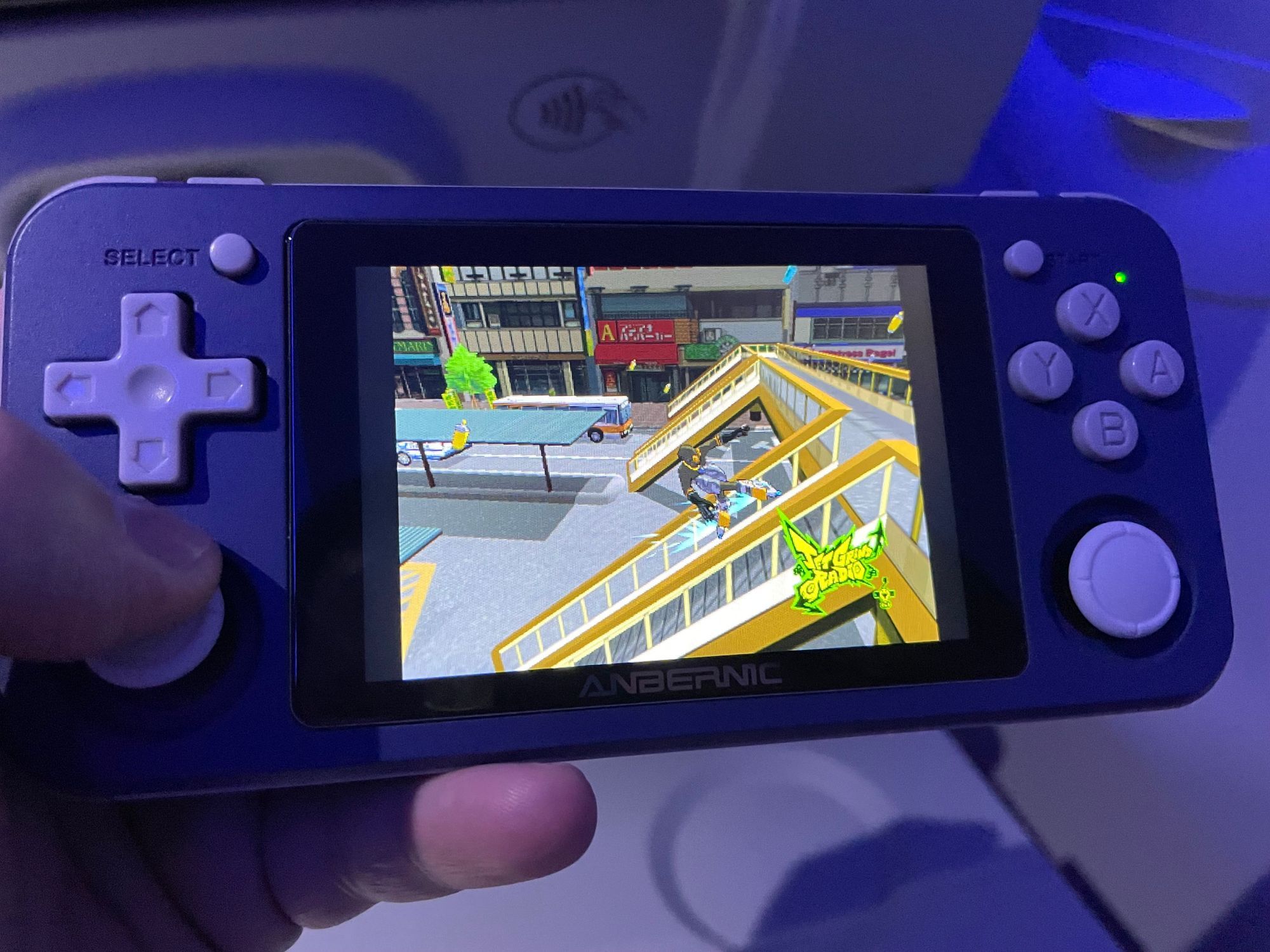Everything about the Anbernic RG351p appears incremental at face value. To start with, its name is literally just one better than its predecessor, the RG350p. The RG351p's hardware is a riff on Hardkernel's ODROID-GO Advance handheld. Its venerable Rockchip RK3326 processor should feel right at home to anyone who's done a cursory tour of the retro handheld scene. Its enclosure is another take on Anbernic's burgeoning house style of smooth rounded corners. On the software end, there's a plethora of community firmwares all making tweaks to a common Linux underpinning. To drive this point home, one of them is affectionally called ArkOS, or Another RK3326 OS.
The Anbernic RG351p is hewing to a well worn path. Despite all of this, it's not another also-ran device. Anbernic (and the community of custom firmware developers) have leaned on the industry's knowledge and experience, putting together one of the most polished experiences in the entire retro handheld scene. Let's not bury the lede here. As of Summer 2021 when this review is being written, the Anbernic RG351p is one of the finest retro handhelds available on the market.
Designing a retro-inspired experience is an inherently tricky proposition. You're not competing with the classic gaming experiences of yesteryear, you're competing with player's memories of them. Classic games and canonical devices will always live large in people's memory. Handhelds and indie games alike have tried to mimic these experiences to a T, carving out Raspberry Pi portables in the shape of of original Game Boys, or creating 8-bit experiences that perfectly mimic the Nintendo Entertainment System's limited color palette. However, the more successful of these retro-inspired outings generally don't limit themselves to the exact constraints of the experiences they're trying to capture the essence of. Titles like Yacht Club Games' Shovel Night have realized that you can use classic works as a jumping off point, but use modern techniques such as parallax scrolling without ruining the experience. You're trying to recapture a feeling, not mimic a fidelity.
This appears to be the approach that Anbernic has taken here. The RG351p looks like, well, an Anbernic device. The team's been developing their own design style for a few device generations now, focusing on rounded rectangles and a sleek, modern profile. They draw their retro influences where they count however. The RG351p's controls are near-perfect, with the d-pad and face buttons feeling remarkably close to an SNES controller, and the analog sticks have gone for a modern Switch-style approach that feels solid enough to potentially be legit surplus inventory. The screen is a pixel-double of the original Game Boy Advance's 3:2 aspect-ratio display. Paired with the classic Indigo coloring, this handheld is one is the perfect home for a deep-dive into the GBA catalog.
Prices fluctuate a bit, but the Anbernic RG351p will generally set players back around $100 USD. This is the current price on Anbernic's official Aliexpress store, as well as various Amazon resellers with faster shipping. For an extra $40, you can also pick up the all-metal RG351m which we'll discuss later in this review. It is likewise available on Aliexpress and Amazon.
The Hardware

The RK3326 is described as "venerable" for a reason. The RG351p's RockChip system-on-a-chip is used extensively in the current generation of retro handhelds. It serves as the basis for the RP351p, Anbernic's RG351v, Powkiddy's RGB 10 and RGB10 Max, the GameForce Chi, the ODROID-Go Advance, the ODROID-GO Super, and the RK2020. It features a 1.3 GHz Cortex-A35 Quad Core CPU, which can be overclocked to around 1.5 GHZ. The RG351p has a Mali-G31 MP2 GPU, which is clocked at 650 MHz. Like most devices of its ilk, it features a respectable 1GB of onboard RAM.
The RG351p has a 3.5", OCA-laminated IPS screen. This is a fancy way of saying that it's a modern LCD screen. OCA lamination is a process of bonding an LCD screen to its glass, so that you don't see the "gap" that's noticeable on classic Game Boys, flip phones, and some older generations of Chinese handhelds. It has a 320 x 480 resolution, which the clever clogs out there may have noticed that this means the RG351p's screen has a 3:2 aspect ratio. This is a crucial stat when it comes to retro game emulation. The RG351p has exactly twice as many pixels as the Game Boy Advance, but it has to make some compromises when playing console games that were designed to be output on a CRT TV with a 4:3 monitor. This topic warrants a full conversation, and is discussed in its own section further down in this review.
Rounding out the technical specs, the RG351p has a 3500 mAh that gets about 5-6 hours of battery life. As is common with these sorts of handhelds, the battery indicators within the OS aren't incredibly accurate. Once you get down to around 30%, it's generally time to start topping it up. It has a USB-C port for charging, and a second USB-C OTG port for accessories. There's an SD card to store the device firmware and games files, and a 3.5" headphone jack. Like all RK3326 devices, the RG351p lacks any sort of HDMI-out capabilities.
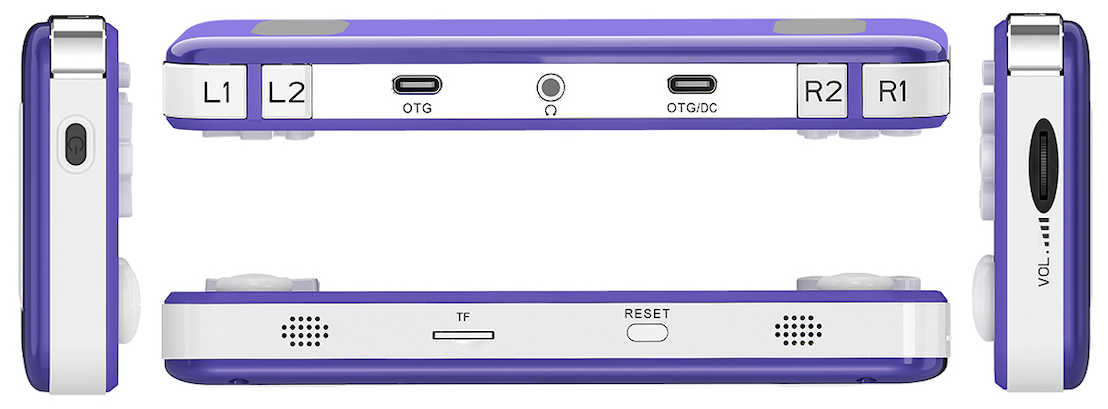
We'll touch on the differences between the RG351p and RG351m a bit later, but the largest hardware change between the two is that the plastic RG351p model does not come with built in wifi. Most RG351p sellers will include a USB-C OTG adapter and a USB wifi dongle however. Wifi can be used to download new game files, sync with RetroAchievements, and run software updates. The onboard wifi of the RG351m is convenient, but it's not a deal breaker when comparing the two devices.
Physically, the RG351p is 151.5 mm x 70 mm x 18 mm. This long and relatively narrow shape gives it the same basic footprint as a modern smartphone, albeit one that's almost two centimeters thick. It's probably not going in one's jean pockets any time soon, but it's easily the sort of device one could toss into a jacket pocket if you're not overly concerned about scratches. For what it's worth, most RG351p retailers do include a screen protector for the device. The overall construction of the device is incredibly sturdy. The plastic version of the RG351 is tightly screwed together, and doesn't offer any unexpected flexing or creaking when playing games.
When laying out the controls of the RG351p, Anbernic made the assumption that you're most likely going to be using the d-pad, with the analog sticks serving as a secondary input. This is a good call given the handheld's Dreamcast and N64 performance. The choice to put the left and right analog stick on the bottom of the device makes sense, and the Sony-style layout feels natural when taking advantage of the handheld's more capable Playstation 1 emulation. Both of the analog sticks are slightly sunken into the device, and have support for L3 and R3 style "clicks".
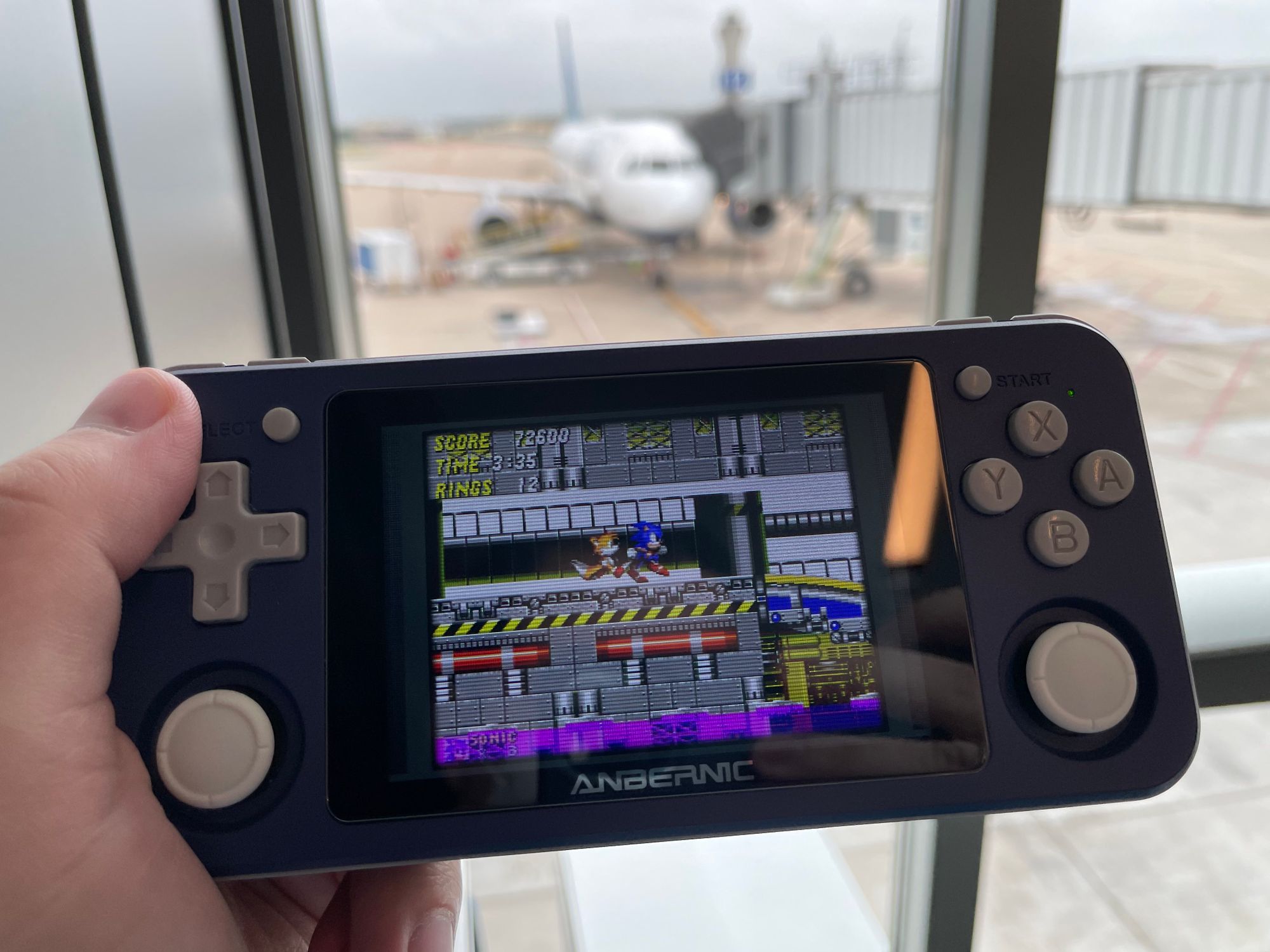
It's hard to overstate just how nice the d-pad and face buttons feel. For such a critical part of a handheld, it's a surprisingly easy facet to get wrong. The RG351p uses a "membrane" style approach to its buttons. There's contact points on the handheld's PCB circuitboard to read inputs, and a plastic button or d-pad up top. Sandwiched between them is a mushy rubber membrane which bridges the circuit and makes the actual connection to send the button input. It's the technology Nintendo's used for most of it's controllers, and gives the RG351p a high quality feel that doesn't show through in pictures.
The shoulder buttons are the one part of the RG351p's design where you can start to see compromises start to creep into the device. When designing a device that can play Playstation 1 games with the physical profile of a Game Boy Advance, you're left with the question of what to do with the Playstation's four shoulder buttons. Anbernic's gone with what was a popular design decision during the RK3326-era. It has the primary L1 and R1 shoulder buttons curved around the side of the device, making them easy to tap during a heated moment of F-Zero. The L2 and R2 buttons are perched up on the top of the device, requiring a bit more finesse to reach. This can be less than ideal in a frantic Mega Man Legends firefight, but overall the approach works. The controls aren't too difficult to reach, and the number of titles that take advantage of all four shoulder buttons is relatively small. As retro handhelds become more capable however, it's telling that most upcoming devices are opting to go with a "stacked" Playstation-style shoulder button experience.
By the time Anbernic got around to placing the RG351p's speakers, there weren't many places left to put them. The stereo speakers are mounted on the bottom of the device, pointing out the bottom. This setup works fine, since you're typically holding the device angled towards yourself anyways. To control the volume, Anbernic's opted to go with a classic volume wheel. This, along with their prescient choice of an indigo color option, really help tie the RG351p to a lineage carved by the Game Boy Advance. Overall, the RG351p and RG351m are a nice, compact, well designed piece of portable gaming goodness.
What Can It Play?
| Fully Playable |
|---|
| Nintendo Entertainment System |
| Super Nintendo Entertainment System |
| Nintendo Game Boy |
| Nintendo Game Boy Color |
| Nintendo Game Boy Advance |
| Nintendo Virtual Boy |
| Sega Master System |
| Sega Genesis / Mega Drive |
| Sega CD & Sega 32X |
| Neo Geo Pocket & Color |
| Sony PlayStation |
| Somewhat Playable |
|---|
| Nintendo 64 |
| Nintendo DS |
| Sega Dreamcast |
| Sony PlayStation Portable |
| Not A Change |
|---|
| Sega Saturn |
| Nintendo 3DS |
So those numbers and measurements are good, but what can this thing actually play? The RG351p has access to a software catalog that is comparable to most other RK3326 devices. The adjacent table runs down some of the more popular systems, and a full list can be found on this wiki page, but at a high level, most 2D handhelds and consoles shouldn't be an issue for the RG351p to emulate. It handles all the classic 8-bit systems, and doesn't misstep during the 16-bit era. There aren't any issues with tricky-to-emulate SNES games such as Yoshi's Island or Star Fox, the Sega Genesis runs well, and the more demanding Game Boy Advance games pass with flying colors.
Things get interesting when you enter the era of 3D consoles. These devices have generally been more difficult to reverse engineer, and a lot of their more difficult emulation problems have been solved by throwing raw horsepower at the problem. Performance varies greatly between consoles, and unfortunately there's a lot of rough spots here.
The Playstation 1 fares best out of all these consoles. Sony went with a rather straightforward architecture for the Playstation, and choose well documented off-the-shelf components. Nearly the entire Playstation 1 catalog should run well on the RG351p. More demanding games like some of the later Final Fantasies run well on the handheld, and thanks to its dual analog sticks, it's one of the few handhelds on the market that can actually play Ape Escape.
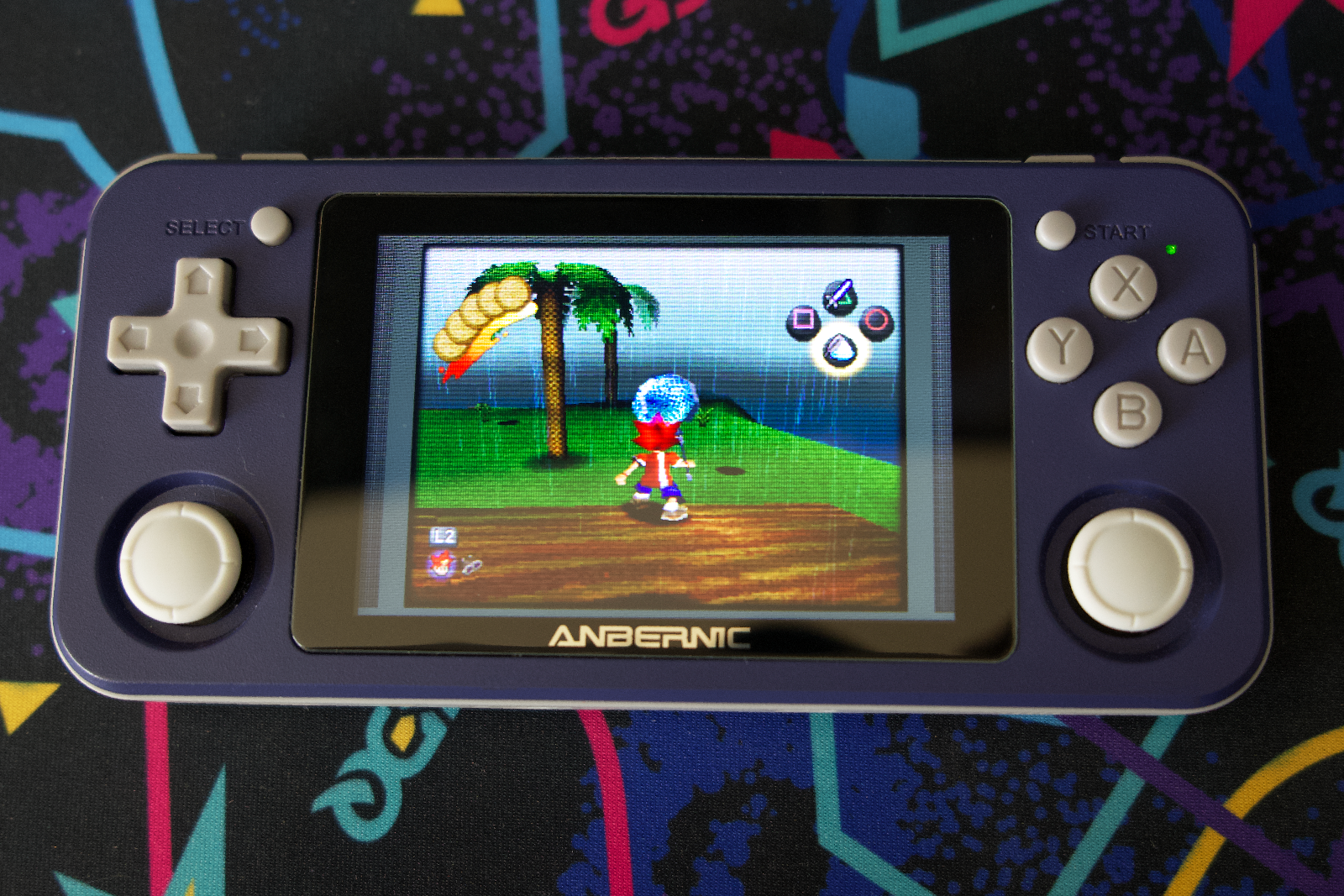
The next best 3D consoles on the RG351p is interestingly enough, the Sega Dreamcast. Like Sony, they chose to go with mostly commodity hardware for their last console outing, and so emulator authors were able to optimize things to a surprising amount. Unfortunately however, the Dreamcast is still a relatively modern console, and so its catalog has a habit of pushing the RG351p to its limits. Some titles like Jet Set Radio work well on the RG351p, but others like Crazy Taxi have enough stuttering and lag to make it not worth the effort. Unfortunately, Sega's two Sonic Adventure titles are on the borderline here. They're playable, but have enough graphical issues and stutters that all but the most die-hard Sonic fans will probably stay away.
With some of these 3D consoles, it's best to think about the working games as nice bonuses to the RG351p. The majority of the Dreamcast catalog isn't in what most people would describe as a playable state, and unfortunately the Nintendo 64 fares even worse.
The Nintendo 64 has always been difficult to emulate. While the Playstation has full compatibility on relatively slow hardware, the N64 is still juggling different emulation cores and profiles, and trying to make up for gaps in optimization with raw computational horsepower. There are a few Nintendo 64 games which run really well. Super Mario 64 and Banjo Kazooie are eminently playable on the RG351p, and Wave Race 64 is close to full speed. Other games are unplayably slow however, such as Goldeneye 007, or even some launch titles like Pilotwings 64. If you're trying to scratch a nostalgic N64 itch, the RG351p will most likely disappoint. As will most handhelds currently on the market unfortunately. Your best bet is to wait for the next generation of retro handhelds, or buy a USB N64 controller for your PC.
Counterintuitively, the Sega Saturn flat out does not work on the RG351p. Unlike the Dreamcast, Sega chose to go with an incredibly complicated architecture for the Saturn. It features two discrete CPUs working in tandem, and has another half-dozen CPUs handling the graphics, sound, and other ancillary tasks. It's been a nightmare for emulation authors, and due to the console's short lifespan, there's also a relatively low demand for further optimization. NiGHTS into Dreams fans will sadly have to look elsewhere for their emulation needs.
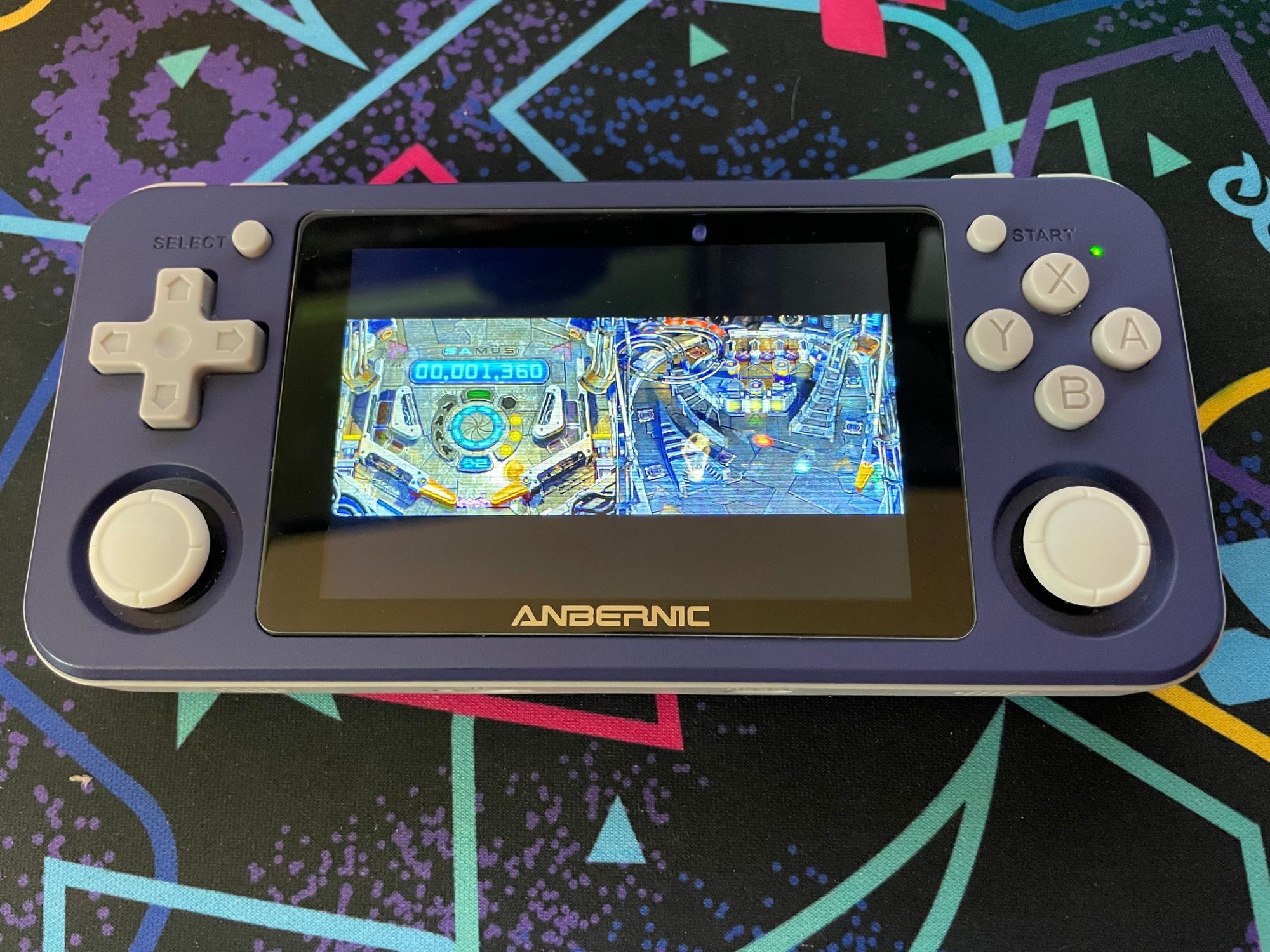
On the 3D handheld side of things, the Nintendo DS runs surprisingly well on the RG351p. The largest issue, naturally, is that the RG351p only has one non-touch screen. The Drastic emulator has a few workarounds for this, such as using an analog stick to mimic touch inputs. Additionally, it also has a variety of screen configurations, such as letting you switch between screens, or displaying them side by side. These accommodations don't work for every title, but they enable a surprisingly large amount of DS games.
The PSP is a more demanding handheld, but it also runs fairly well on the RG351p. You don't be able to pull off more demanding games like God of War or Metal Gear Solid: Peace Walker, but there's a host of less demanding games you should be able to run. The PPSSPP emulator offers a large assortment of frameskip options, so you can usually nudge borderline games into a passable state. There's still a burgeoning PSP and PS Vita enthusiast scene however, so if the Playstation Portable is your focus, it may be worth just picking up one of the native devices.
As far as arcade games go, the RG351p has support for the MAME emulator. There's less of a definitive cutoff for when games stop working here, and you can get a good way into the 90s on Anbernic's little handheld.
Outside of emulation, there's a surprising number of games that can run natively on the RG351p. The handheld runs a slimmed down Linux operating system, and while Linux isn't a bastion of gaming (yet), there's a good number of titles on offer. Most of these games were ported to Linux from other platforms, so these non-emulated native apps are collectively known as "Ports" by the community.
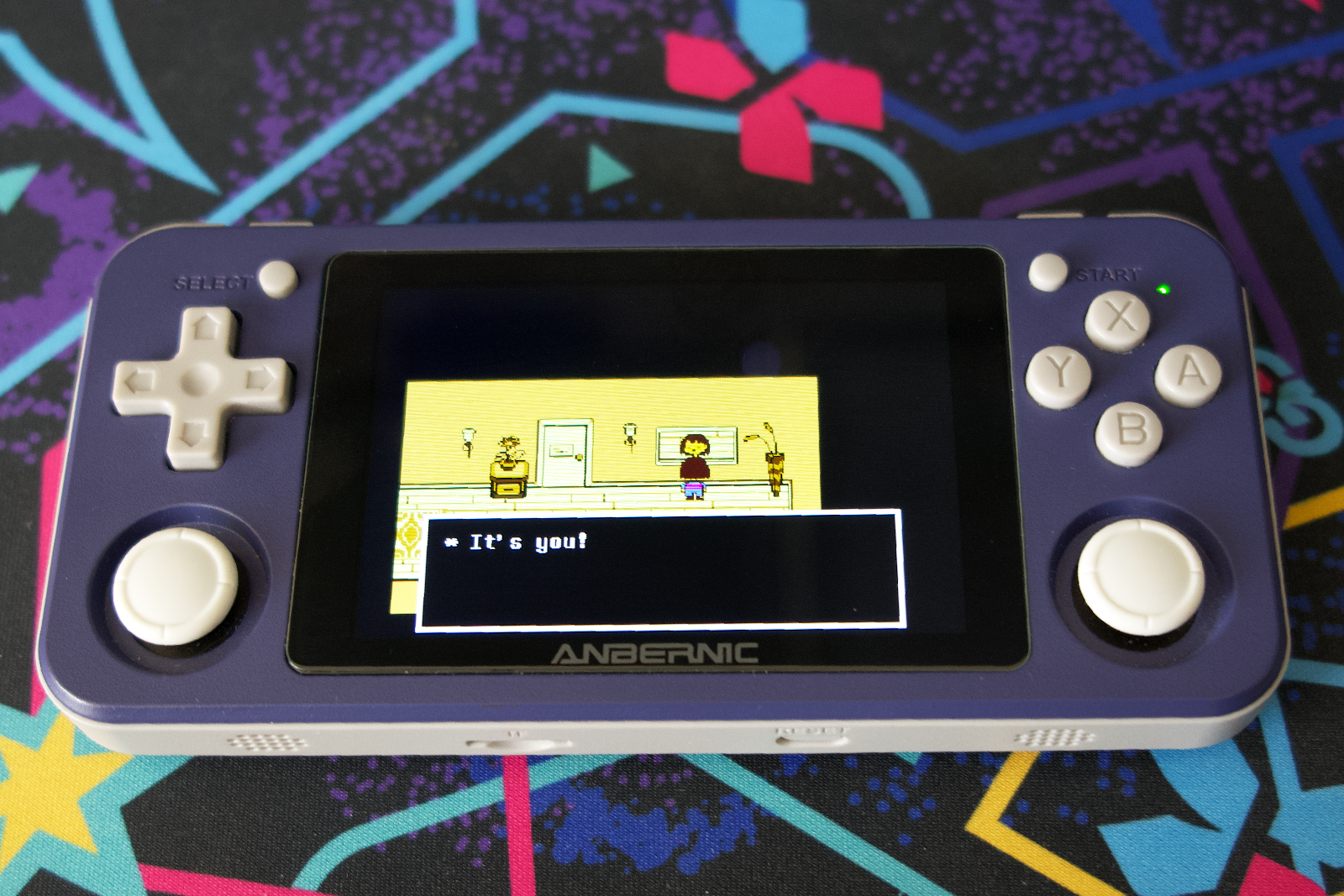
A surprising number of these Ports are commercial games with legitimate Linux releases. Titles like Undertale and Shovel Knight can be downloaded off of Steam and finagled onto the RG351p without too much drama. Likewise, a number of indie games and fan games have Linux versions which run well on the RG351p. If you haven't gotten a chance to check out Cave Story or Sonic Robo Blast 2, picking up one of these handhelds is a good excuse to give them a try. Finally, there was a trend of creating open source reimplementations of FPS engines during the 90s and 00s, so the RG351p can run everything from Doom, to Quake, and even the original Half-Life.
These Ports aren't a replacement for full Android Play Store access, but they're a nice bonus to the RK3326 ecosystem. Installing a Port usually involves copying over a launcher script and game asset files, but there's also a few community installers apps to help streamline the process. Anberports was the first and most well known, but it's since gone defunct. PortMaster recently launched to try and fill the gap left by it. There are also a few Ports that are tied to specific RG351p custom firmwares, which segues into our next topic nicely.
Firmware Overviews
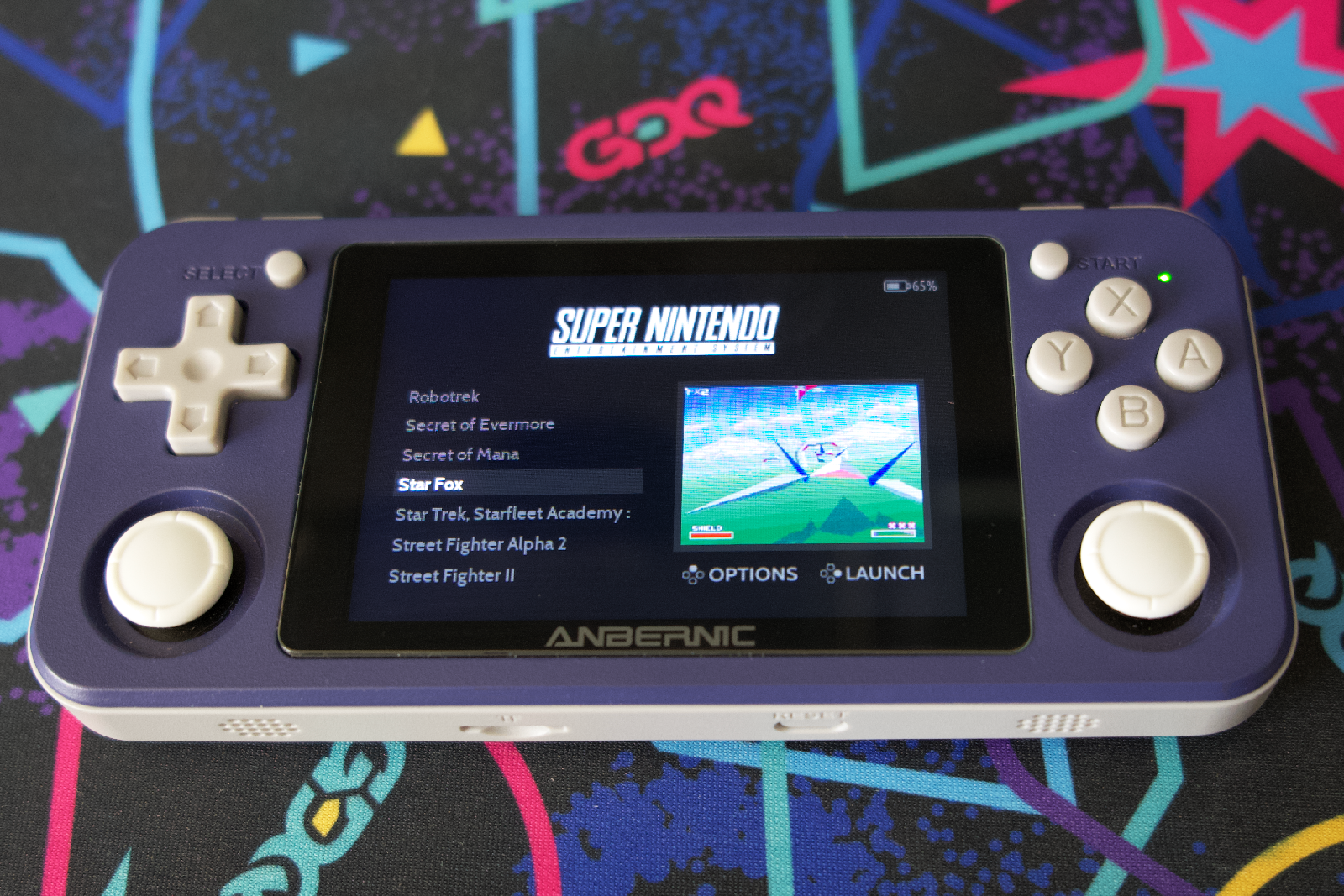
The stock firmware for the RG351p is a custom version of EmuElec. This Linux-based firmware combines a variety of open source emulators, frontends, and tools, which users of the Retro Pie Raspberry Pi image may already have a passing familiarity with. To help organize and launch games, EmuElec takes advantage of the Emulation Stationfrontend. The vast majority of EmuElec's emulators are based off of RetroArch and its "Cores" system.
For the most part, EmuElec is a solid out of the box experience. It hasn't been updated since the RG351p's launch however, so several community-backed custom firmwares have cropped up in the intervening months so help polish the experience further. There's a few different firmwares out there, but the most popular two generally are 351Elec and ArkOS.
For a while, these two firmwares were constantly releasing new features and enhancements, pushing the limits of what the RG351p was capable of. Due to the open source nature of this whole affair, the other firmware would generally be able to adopt whichever new functionality was taking the scene by storm. However, the RG351p has been out for almost a year now, and there's an increasingly small number of areas for improvement. The ArkOS project has stopped supporting the RG351p, and while the 351Elec project is still going, it's reached a similar level of maturity.
Both of these firmwares use the same Emulation Station and RetroArch foundation as EmuElec. Unless there has been some advancement since the time of publishing this article, the primary difference between the two firmwares is the philosophy they take to getting the handheld set up. 351Elec provides users with a preconfigured experience, aiming to have smart defaults for the most popular consoles and handhelds. ArkOS provides users with a blank slate, letting them tailor their experience to their exact whims. Both approaches are completely valid, but 351Elec generally provides the more straightforward user experience.
Regardless of which custom firmware you decide to go with, the process of setting it up couldn't be easier. All you need to do is plug your SD card into your computer, and write the firmware image to the card. (Similar to setting up a Raspberry Pi.) Once you insert the SD card into your handheld and turn it on, it will go through a few one-time setup scripts before you're ready to go. At that point, all you need to do is to remove the SD card, plug it back into your computer, and transfer any game files you'd like to play onto the card.
The firmware is stored on the card itself, so if you have multiple SD cards, you can actually switch between firmwares on the fly. Emulation Station provides a nice per-console view of your games, and if you plug in a wifi dongle, it can download game metadata, box art, and other related media. Once you've decided which game you want to play, Emulation Station will automatically open up the correct emulator and launch the game. This is generally RetroArch, but for some of the more demanding consoles, there's also a lightweight RetroRun emulator which Emulation Station can start for you. Both the Emulation Station and RetroArch experiences are fully customizable, letting you set up new themes and emulator tweaks without too much difficulty.
While there are some technical aspects of getting the device set up, such as writing a firmware image to an SD card, it's overall an incredibly straightforward experience. There's a healthy amount of settings and configurations for tinkerers to play with, but if your primary focus is just playing your favorite games without too much hassle, the RG351p is a great device for beginners. Once you've got everything configured, launch a game is just a matter of turning the handheld on, picking which console you'd like to play, and selecting a game from a list.
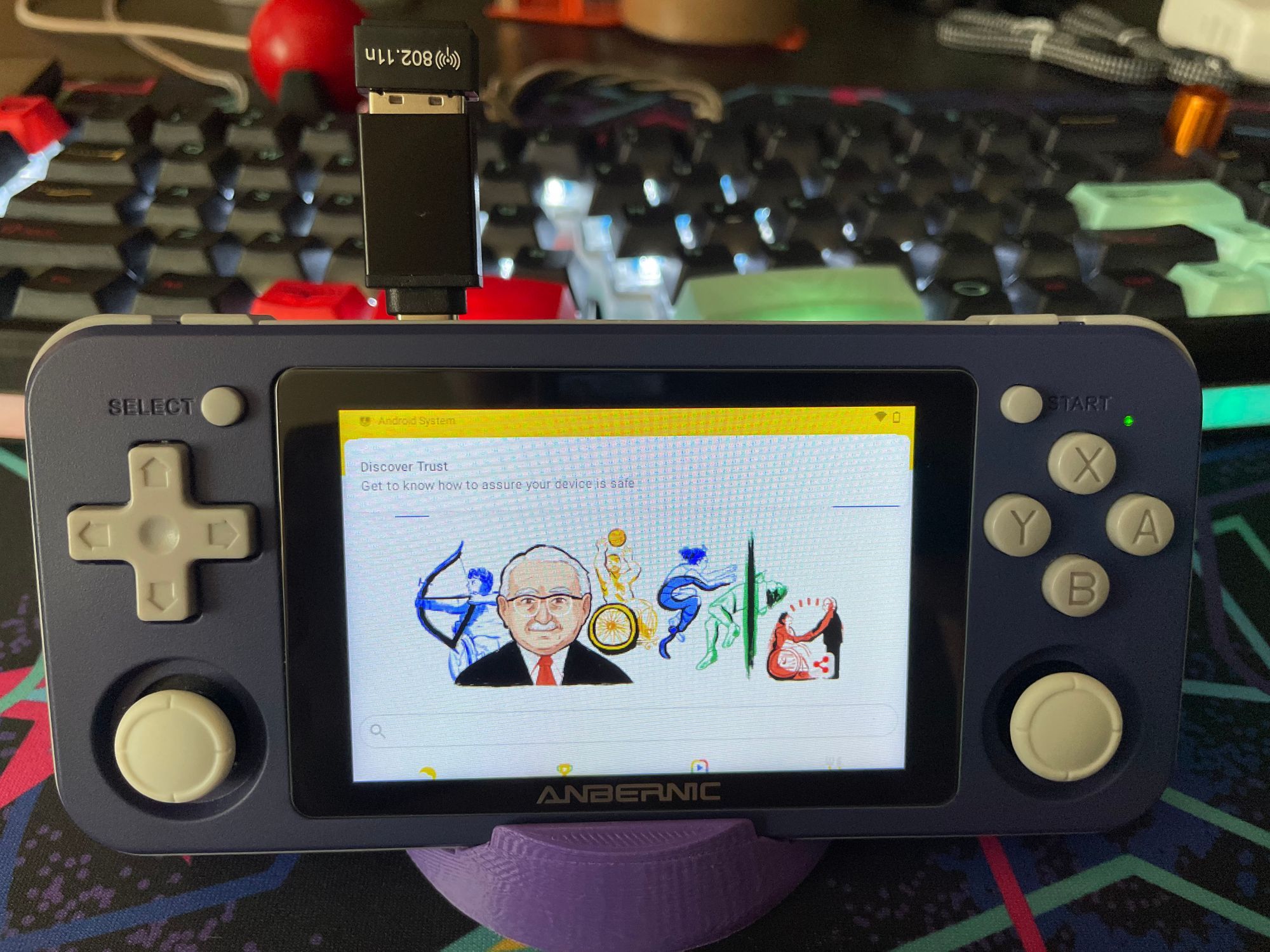
For the more adventurous RG351p owners out there, the 351Droid project is pushing the limits of what the RK3326 handhelds can do. Instead of running Linux, 351Droid introduces the LineageOS Android distribution to the RG351p. It's still in its early stages, and you'll need a USB-C OTG adapter with a mouse and keyboard for a lot of tasks, but the dev team recently cracked the nut on wifi support, and is working to polish the firmware for a full release.
So About That Screen
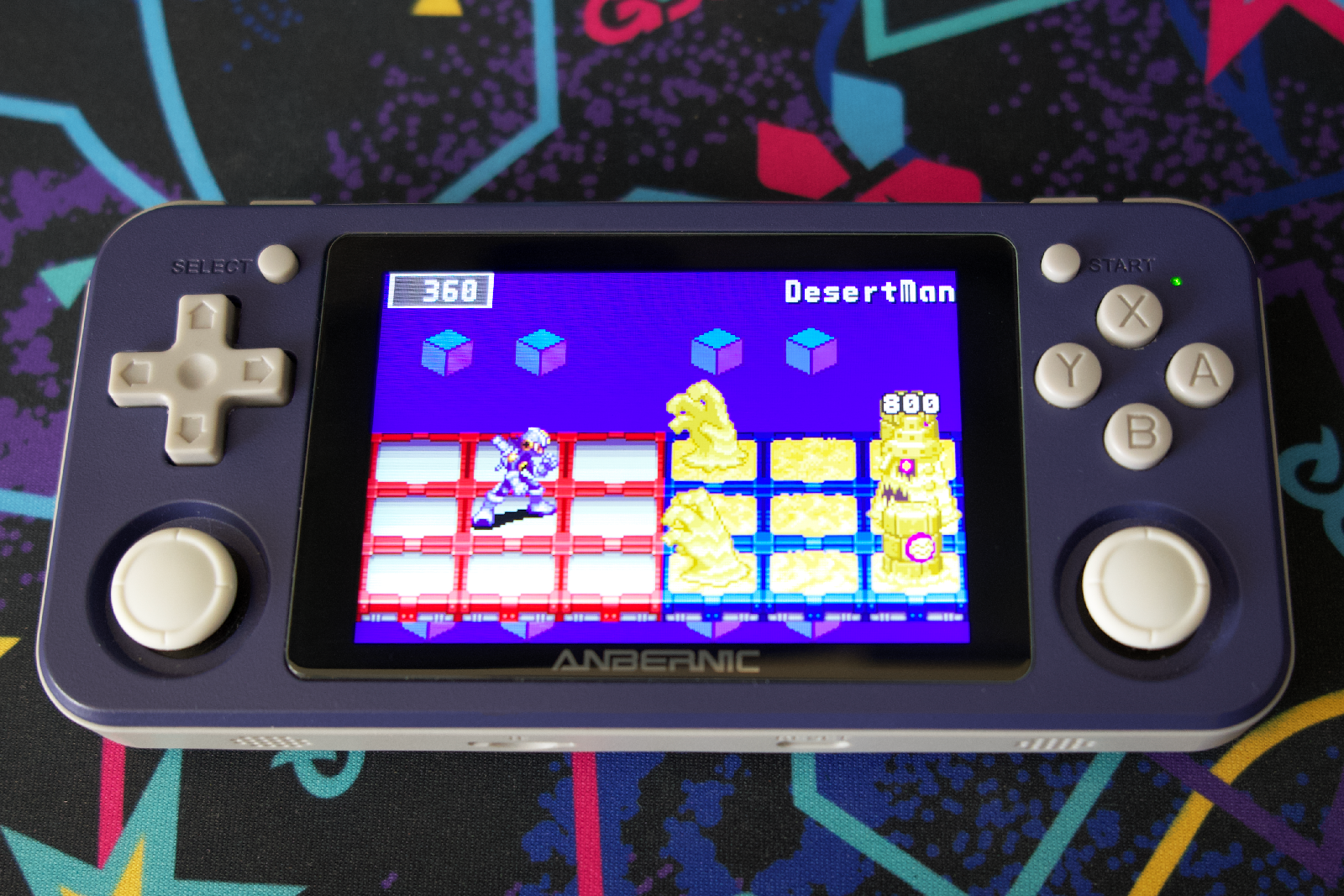
It's finally time to talk about the elephant in the room. The RG351p has a 3:2 aspect ratio screen, and the majority of the games you're playing on it are probably some variation of 4:3 (consoles played on a standard television) or 10:9 (the original Game Boy and Game Boy Color). The only system which performs flawlessly on the RG351p is the Game Boy Advance. The GBA's screen resolution is 240×160, which is exactly half of the RG351p's 480 x 320 screen. If you scale the Game Boy Advance's image up 2x, it's a crisp perfect match. For everything else, you're dealing with some level of black bars and scaling.

Black bars irritate some players to no end, but they're generally a fact of life when emulating. Thankfully, the RG351p's 3:2 screen isn't as an egregious for 4:3 content as say, a 16:9 screen. There's some minimal bars on the left and right of the screen, but nothing too egregious. PSP games likewise have some small bars on the top of the image. The DS games either have a similar 4:3 appearance in single-screen mode, or some small black bars on top if you opt for a side-by-side approach. The original Game Boy fares worst, with prominent black bars on the side of the display.

Thankfully, RetroArch-based consoles and handhelds can take advantage of the emulator's robust border support. Similar to how Super Game Boy would display a border around Game Boy games on the SNES, RetroArch can show a variety of static images beside your games to help fill out the rest of the screen. This is a matter of taste, but there's a few good community border packs out there for interested parties to check out. There's a few game-specific backgrounds (once again, calling back to the Super Game Boy), as well as some generic borders mimicking the hardware bezels of classic systems.
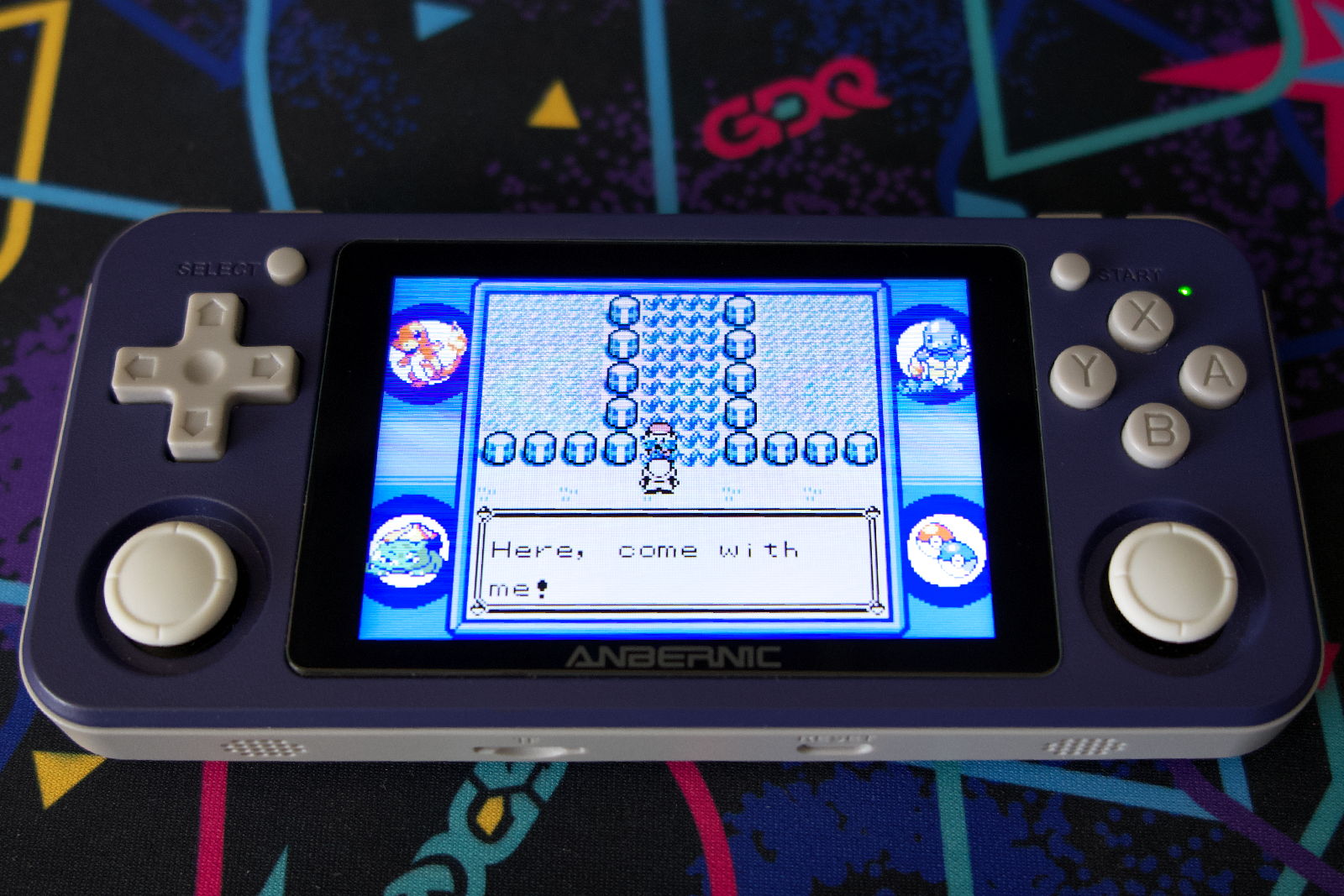
Scaling is where things get more contentious. 4:3 console based games use a 256×224 resolution. This doesn't have a nice 2x scale with the RG351p's screen. If you double the 224 vertical resolution, you get 448, which is over a hundred pixels too tall for the RG351p's screen. That means the RG351p is going to need to do some amount of scaling. What happens when you need to turn one black pixel and one white pixel into a single pixel? Do you make it gray? Do you ignore the second pixel? There's a lot of different factors that go into making a scaled image look right, and thankfully the RG351p has hardware scaling built into the device itself. Its "RGA Scaling" mode makes most console games look as they should, even on the RG351p's smaller screen.
Incidentally, this scaling issue is a decent excuse to test out the extensive selection of RetroArch's shaders, particularly if it's been a while since you've last taken a look at them. As various popular Twitter accounts have started highlighting, most retro games were not designed to be played on a crisp pixel dense LCD display. They were made with the technology of the era in mind, and CRT TVs did a nice job of naturally blending pixels together for a natural anti-aliased look. The RG351p has a good selection of CRT and LCD themed shaders which make games look a bit closer to how they appeared back in the day.
Plastic or Metal?
This review of largely been about the plastic-bodied RG351p. On a technical level, it's metal-enclosure cousin the RG351m is a nearly identical device. The one distinguishing characteristic between the two is the lack of built-in wifi on the RG351p. Otherwise, all observations about gaming performance are completely similar between the two.
So, is the metal enclosure worth it? That question largely comes down to personal finances. At $140 USD, the metal RG351 costs a decent amount more than its $100 USD plastic counterpart. The metal body feels premium and solid, but the RG351p wasn't exactly slouching in that regard. It's plastic body feels sturdy as well, and doesn't give off any telltale flexing of a cheap device.
So largely the choice between metal and plastic just comes down to personal taste. Metal options for devices have become increasingly common, particularly if you consider some of the aftermarket enclosures available. The RG351m can serve as a fun curio or centerpiece of a collection. Owners of both will occasionally comment that the RG351m feels noticeably heavier than the RG351p, and that the plastic model can be a bit more enjoyable for longer gaming sessions.
Thoughts From The Community
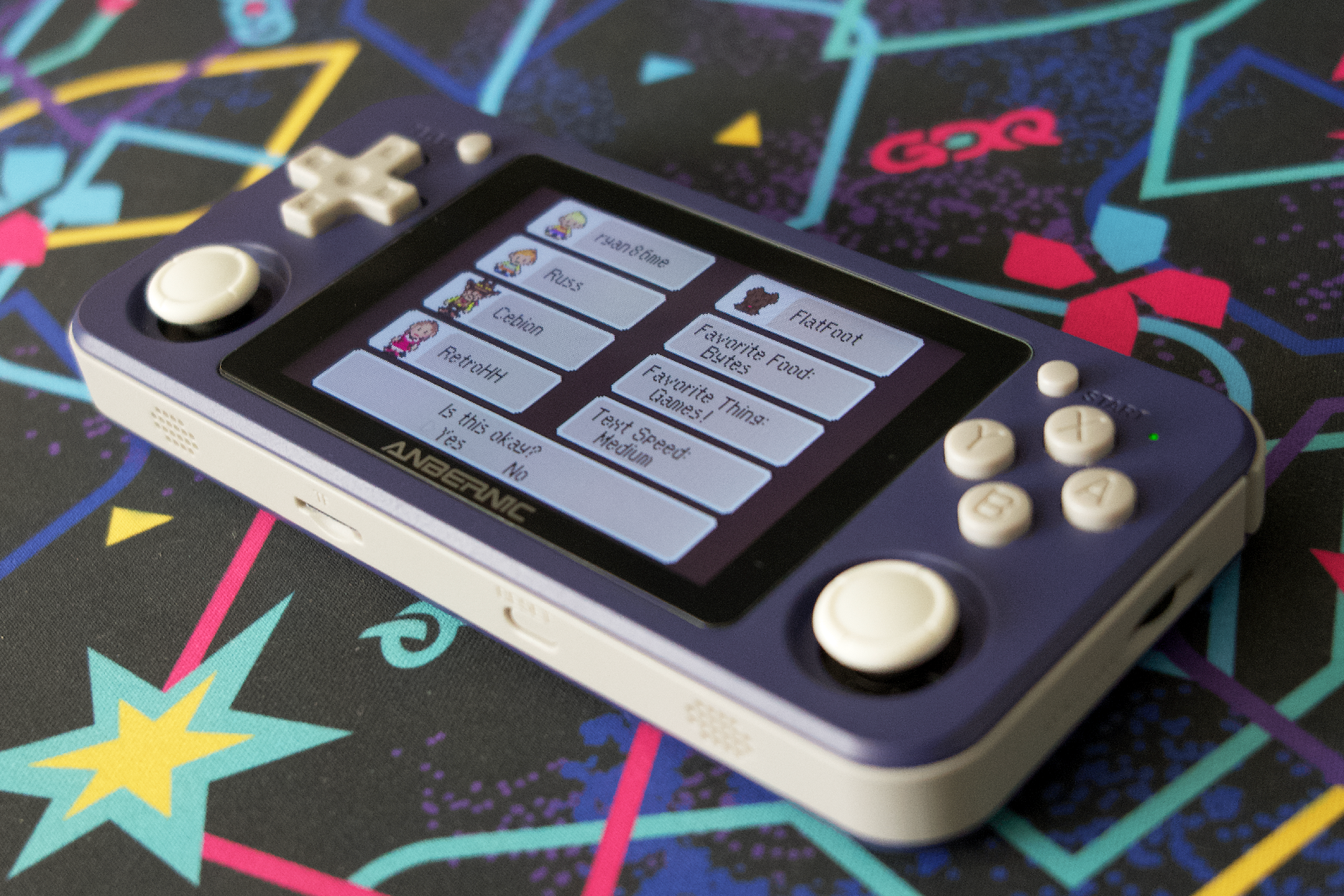
Reviewing a device will always be a subjective process. As a part of these device reviews, we generally like to highlight a variety of viewpoints from around the Retro Handhelds community. Here's what you all had to say on the RG351p and RG351m:
"From a power and hardware perspective, the RG351p/m devices barely seem like an upgrade from the RG350 series: They're about 50% more powerful, but with a lower resolution screen in the wrong aspect ratio. Essentially, these devices play PS1 and SNES better than the RG350s, and tease you with just-adequate-enough PSP, N64, Dreamcast, and NDS emulation. But what makes the RG351 series stand apart is their inclusion of EmuELEC-tangent firmwares with PC/Mac-readable storage partitions, which simplifies the user experience and opens them up to a wider audience. Also, if you love GBA, the 3:2 aspect ratio makes the RG351p/m the best devices available!" Retro Game Corps
"Better than the sum of its parts. Great build quality, an intuitive user interface and a pocket-friendly size make this a fantastic pick-up-and-play handheld, albeit one that struggles to emulate higher-end systems. If you instead focus on what the RG351p is good at (up to PSX / GBA), you'll be getting one of the best portable emulation experiences on the market." –ryan86me
"The RG351p has one of the best build qualities I've seen and does not need to hide between the big players. It reminds me of the Gameboy Advance I had as a child. Awesome to hold and fun to play." –Cebion, 351Elec Developer
Conclusion
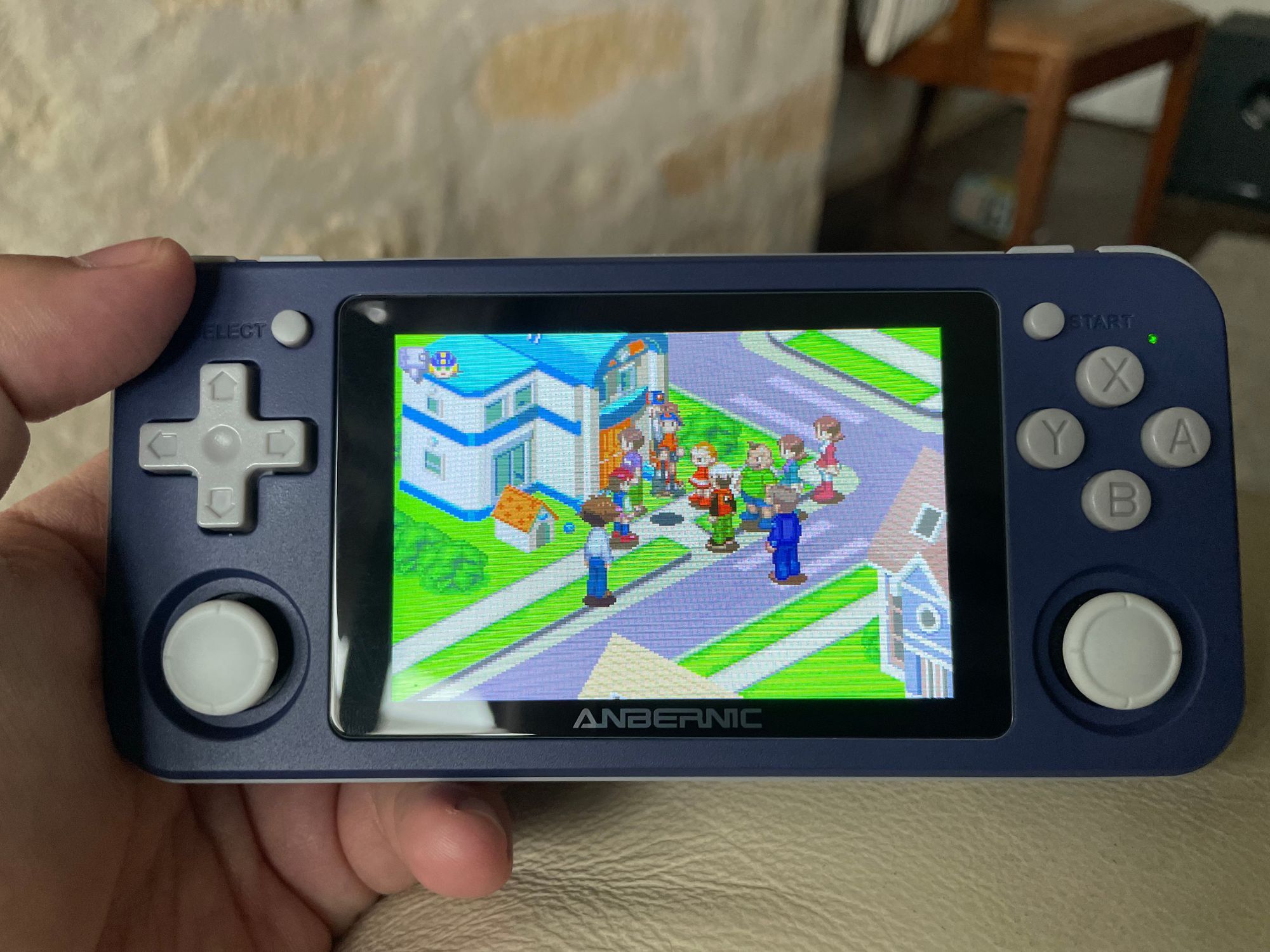
In a way, the RG351p suffers a bit from middle child syndrome. It's strengths are generally the sort of thing you notice when shopping for your second retro handheld. It doesn't have a throwback design like the Anbernic RG351v, and it lacks the eye-catching color options of the Retroid Pocket 2. It may not have a defining characteristic, but it excels at nearly everything it sets out to do. The handheld isn't without its flaws, but even its flaws add a bit of character to it. If nothing else, this handheld is the ultimate Game Boy Advance machine.
We unequivocally recommend picking up the Anbernic RG351p or the RG351m. Once again, it can be purchased for roughly $100 USD from Anbernic's Aliexpress store, as well as various Amazon resellers.
Delicious:
- Compact shape and size.
- Buttons feel like a classic SNES controller.
- Easy setup & firmware upgrade process.
- Built-in frontend and scraping support.
- 351Elec provides smart defaults for most system settings.
Suspicious:
- No HDMI out.
- N64, Dreamcast, and PSP performance is less than ideal.
- Ports more limited than Android app stores.
- 3:2 screen has black bars on most systems.
Verdict:
- This device belongs in everyone's collection, if only to justify finally crossing Mother 3 off your backlog.
